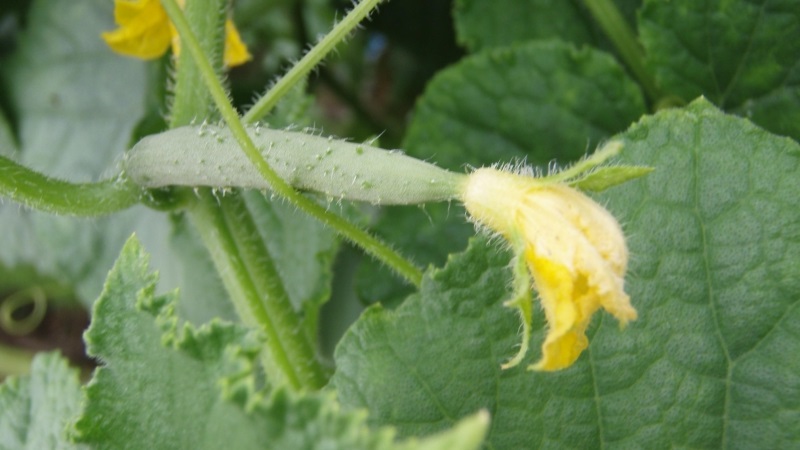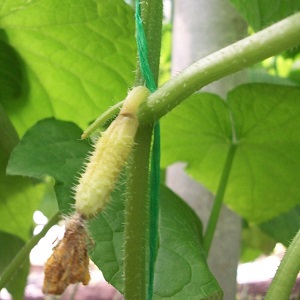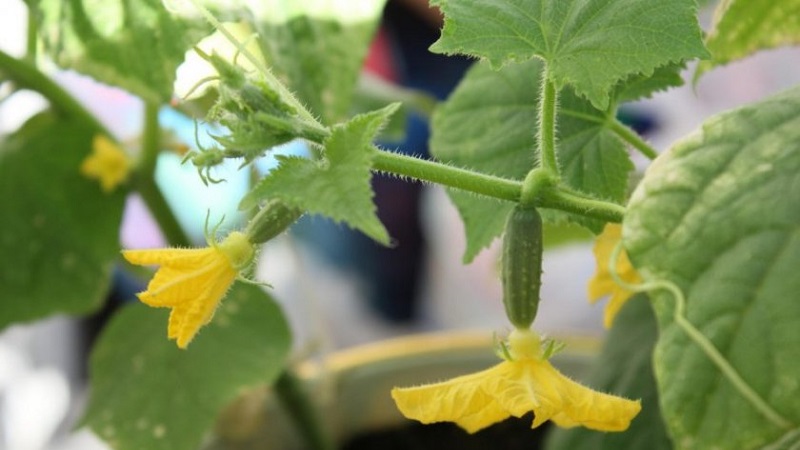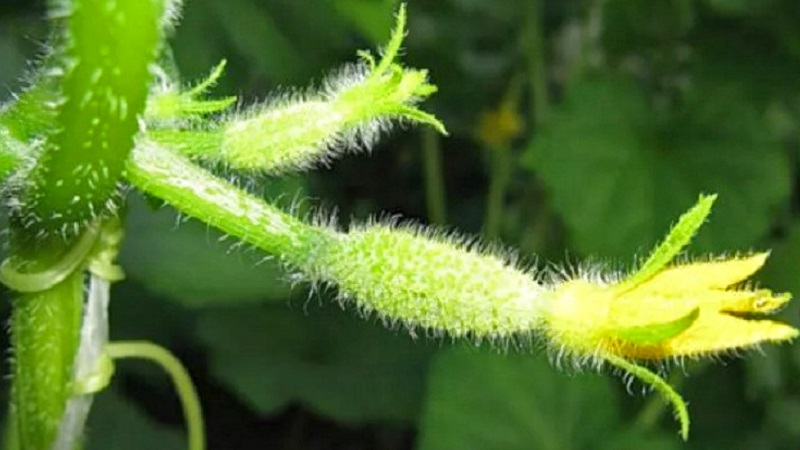The main reasons why the ovary does not grow on cucumbers
Cucumber is the most popular vegetable in vegetable gardens. It is unpretentious, suitable for growing in a greenhouse and soil, and has a high yield. But often there is a problem of poor growth of the ovary on cucumbers.
We will deal with the most common reasons for the absence of ovaries, consider why cucumbers bloom, but no ovaries, ways of solving and preventing the problem.
The content of the article
Why the ovary on cucumbers does not grow or grows poorly
There are many reasons for poor growth of cucumber ovaries.:
 unsuitable temperature;
unsuitable temperature;- improper watering;
- overly tight rows of vegetables and improper molding;
- lack of nutrients;
- poor pollination;
- pests and diseases;
- late harvest and early planting;
- high acidity of the soil.
Unsuitable temperature
Cucumbers hardly grow in uncomfortable conditions... Temperatures below + 12… 15 ° C cause serious harm. In cold, damp weather, plants do not absorb nutrients. The ovaries not only stop growth, but also fall off.
Sharp temperature fluctuations and changes in humidity also reduce yields during the day. If the temperature is normal during the day and drops to + 10 ... 12 ° C at night, then the green mass will actively grow, but the ovaries and flowers will crumble.
The optimum temperature for cucumbers is + 22 ... 26 ° C... In the greenhouse during the day it will be necessary to provide + 20 ... 25 ° C, and at night - not less than + 17 ° C.
Attention! Prolonged heat above + 35 ° C without sufficient soil moisture also has a detrimental effect on the growth of the ovary.
Wrong watering regime
Cucumbers require a high level of air and soil moisture... This is one of the most moisture-loving garden crops. The roots are poorly developed, and the leaves are wide, which facilitates the evaporation of a large amount of moisture.

The maximum demand for moisture is during the mass fruit growth. At this stage, cucumbers are watered every 3-4 days, and preferably every other day. Moisture stimulates the growth of the ovary.
Important! The water must certainly be warm, since cold becomes the cause of the development of diseases, the death of plants.
Before flowering, cucumbers are watered with sprinkling, then water is poured under the bush... It is best to do this before 6 pm.
Fit too tight
If the plants are over-planted, they simply do not have enough food space, they are not able to give many fruits. All this inhibits the growth of the ovary, which lacks nutrients. Planting density should be at least 20 cm between bushes and 50-60 cm between rows on average.
It can be useful:
What top dressing to use during fruiting
Unformed bushes
Green mass "eats" a lot of nutrients, which in the end will not be enough for the ovary. In addition, the thickets do not let in enough light. The formation of bushes is carried out as follows:
- All stepchildren are completely removed from the sinuses of the lowest first 4-5 sheets.
- The shoots that go above are shortened after the 2nd leaf.
Deficiency of useful micronutrients
Ovaries do not grow with a deficiency of feeding... However, nitrogen is useless for cucumbers - its abundance reduces productivity.
At the stage of fruit growth, it is recommended to feed with fertilizer with potassium, phosphorus. Deficiency of these trace elements leads to poor ovary and pear-shaped fruit.Top dressing is repeated every 12 days.

Poor pollination
Often summer residents are not even aware of such a problem. and cultivated in greenhouses varieties pollinated by bees. The number of female flowers prevails, but without a pollinator they will not bear fruit. In this case, you need to take the male flower and gently touch the female flower with it so that pollen gets on the pistil.
It also happens that cucumbers in the greenhouse have tied up, but do not grow. Often gardeners pick barren flowers... This cannot be done. These are male flowers, without which female flowers are not pollinated. With an abundance of barren flowers, stop watering the cucumbers, just spray the ground. Resume watering when the leaves on the lashes are slightly twisted.
Diseases and pests
If there is no ovary on the cucumbers, the cause can be pests and diseases:
 Gray rot... The causative agent is a bacterium that develops at low temperatures. It affects all parts of the plant, there are brown areas and a gray thick coating.
Gray rot... The causative agent is a bacterium that develops at low temperatures. It affects all parts of the plant, there are brown areas and a gray thick coating.- Sclerotinosis, or white rot, is considered a dangerous infectious disease. It appears as white flakes with black dots on all parts of the plant. Soft mucous spots also appear.
- Melon aphid... Small insects destroy everything: flowers, fruits, ovary. During the period of activation, leaves fall off the plant, flowers wither, the yield decreases due to the weakening of the mother plant.
- Spider mite lives on the back of the leaves and feeds on greenery. This red-green small insect is extremely dangerous for cucumbers. It damages the plant completely, braids the leaves with small cobwebs, and is able to destroy entire rows.
Violation of the timing of planting and harvesting
Because the cucumber loves warmth it is planted on the beds when the temperature reaches + 10-12 ° C... It is recommended to treat the soil with a potassium permanganate solution to reduce the risk of developing diseases. Seedlings will be ready for planting at 25-30 days of age with 5-6 true leaves.
Rare and untimely collection of fruits can also delay growth. young ovaries and reduce yields. Remove ripe cucumbers on time, then the plant will have the strength to provide the young ovaries with enough nutrients. At the very beginning of fruiting, the collection is carried out every 2-3 days, and then every day or every other day.
Bad ground
With improper feeding the level of soil acidity increases. Cucumbers do not grow in such an environment, since the acid does not allow the necessary substances to be absorbed. At the same time, the whole plant lags behind in development.
Other reasons
If the cucumbers are tied, but do not growthen lack of sun may be the reason. Seedlings need UV rays to get a good harvest. The lack of light in many cucumber varieties causes a growth retardation: the stems are stretched, but there is no strength left for the setting and development of fruits.

What to do - how to fix the situation and eliminate the causes
Here are some ways to speed up ovary formation.:
- Mulching the soil will help against temperature extremes. The plantings are covered with dried grass, soil, fallen leaves, sawdust, needles, etc. There are even special films. This method not only regulates daily temperatures, but also retains moisture and prevents weeds from growing.
- Water the plants with warm water.
- Cover greenhouse windows at night.
- During the fruiting period, potassium and magnesium are required, nitrogen should be reduced or removed.
- For root feeding, humus, ash, urea infusion and mullein are suitable.
- Harvest more often, do not leave ripe fruits on the bushes.
- Reduce watering if it is too abundant, but do not overdry the soil.
- For greenhouses, use self-pollinated varieties. Otherwise, manually pollinate or open windows during the day.
How to feed
Here options for foliar dressing (by leaves):
- At the beginning of flowering - 10 liters of water with 40 g of urea or 10-12 crystals of potassium permanganate and 1 tsp. boric acid per 1 liter of water.
- At the beginning of fruiting - 30 g of urea per 10 liters of water or 1 tbsp. ash per 10 liters of water (leave for a day and strain).
- With a decrease in yield - Take 12-15 g of urea for 10 liters of water.
Advice! Cucumbers are processed in the evening or early morning, in calm and dry weather. Avoid exposing the plants to sunlight if there are still drops of solution on them.

Several foliar dressings:
- During budding:
- 1-2 tbsp. l. for 10 liters of water "Agricola-5" for cucumbers;
- for 10 liters of water 20-25 g of double superphosphate, 15-20 g of potassium sulfate and 10-15 g of ammonium nitrate;
- in 10 l of mullein solution (1:10) add 20 g of double superphosphate and the same amount of potassium magnesium.
- During flowering:
- 1 tsp. urea, potassium sulfate, superphosphate, 2 tbsp. l. "Effekton-O" for 10 liters of water;
- per 10 liters of water 0.5 g of boric acid, 0.1 g of zinc sulfate and 0.4 g of manganese sulfate.
- During fruiting:
- dilute the herb infusion with water in a ratio of 1: 5;
- for 10 liters of water, take 25-30 g of potassium nitrate, 50 g of urea, 1 tbsp. ash;
- on a bucket of water - 1 tbsp. l. nitrophoska, as well as 2 spoons of "Effecton-O".

Alternate mineral and organic fertilizers 1 time in 2 weeks:
- Chicken manure solution (1:20) or mullein solution (1:10). One plant will require 500 ml.
- Dissolve a nitrophoska matchbox in a bucket of water. 500-700 ml per plant.
Advice! Root dressing is carried out on moist soil, after watering or rain.
there is special preparations for stimulating growth ovary and fruit:
- "Bud";
- "Let us be fruitful";
- "Ovary".
Folk dressing recipes:
- Yeast is one of the most effective fertilizers. You will need 1 pack of baker's yeast for 1 bucket of water. Dissolve and leave warm for 3 days. Stir once a day. Apply after watering, 500 ml per bush. This fertilizer will also protect against pests, but it should be used no more than 2-3 times a season.
- Top dressing with bread is an alternative to yeast. To create foliar fertilization, you need to soak 1 loaf in a bucket of water and let stand overnight. In the morning, knead the bread and add 10 ml of iodine. Dilute the mass with water at the rate of 10 liters per 1 liter of fertilizer. Sprinkle cucumbers.
- Onion peel fertilizer is suitable for feeding roots and leaves and protects against diseases. Take 20 g of husk for 5 liters of warm water. Leave the mixture for 4 days and strain.
Read also:
How to prevent growing problems when growing cucumbers
Prevention is simple:
- plant cucumbers in the ground only when the soil warms up to + 10–12 ° C;
- avoid thickening;
- feed regularly;
- harvest on time;
- monitor pollination;
- ensure proper watering;
- use shelters from temperature extremes;
- form the plant correctly.
Conclusion
The reasons for the lack of a cucumber ovary are not difficult to prevent. To do this, it is enough to study the rules of caring for the plant and provide it with the necessary conditions.
Moderate and timely watering, top dressing, adherence to the temperature regime, the correct distribution of bushes and their formation - all this will contribute to the full growth of the ovary and high yields.